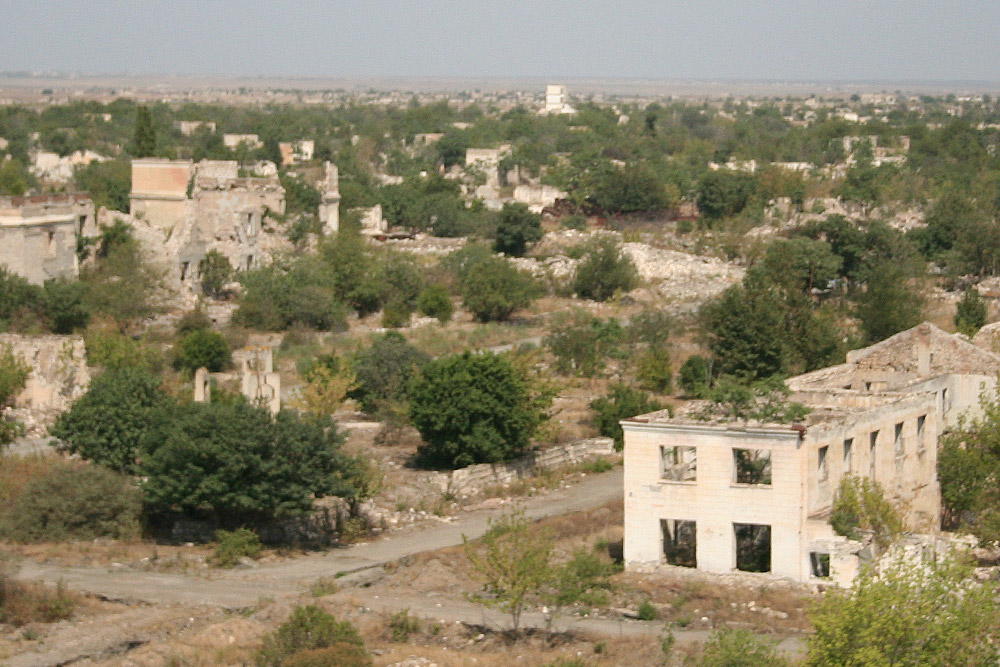Fuzuli, Jabrayil, 21 years of occupation

By Sara Rajabova
August 23 marks the 21st occupation anniversary of Azerbaijan's Fuzuli and Jabrayil regions by the Armenian armed forces.
As a result of the invasion, some 51 villages and the centre of the Fuzuli region were seized by the Armenians leaving more than 55,000 inhabitants displaced.
From 1988, the Fuzuli region has been subjected to constant attacks by Armenians. As a result of the occupation, more than 1100 inhabitants of Fuzuli were martyred, 113 - were taken prisoner and 1450 people were left disabled.
The Fuzuli region is 1386 sq.km with a population of approximately 105,000. Some 13 settlements and 20 villages are located in this region, freed from the occupation. Twelve of the settlements were constructed after release and internally displaced families had been given temporarily accommodation.
The region covers a territory from the south eastern slopes of the Karabakh Mountain range to the Araz River. It borders on the Azerbaijani regions of Khojavand, Jabrayil, Agjabadi, Beylagan and Iran along the Araz River.
The ancient historical monuments of world importance in Fuzuli region were left under occupation and many of them were destructed. After invading Azerbaijan's territories, Armenia has been pursuing the campaign of ruining cultural and historical monuments of Azerbaijani people. The most famous of these monuments is the Azykh Caves, known as a living site of stone-age man.
Discovered by "Paleolithic Archaeological Expedition" of Azerbaijan National Academy of Sciences under the leadership of Mammadali Huseynov in 1960, the cave is considered to be the site of one of the most ancient proto-human habitations in Eurasia.
A Neanderthal-style jaw bone found in 1968 is thought to be over 300,000 years old and thus one of the oldest proto-human remains found in this part of the world. Its discovery gave rise to the term Azykh Man.
Unfortunately, the fate of this, as well as other ancient monuments is unknown due to the Armenian occupation.
The operations section supervising the devastating effects to the environment and natural resources in the occupied territories of Azerbaijan has identified a number of facts of destruction of natural resources by Armenians in the Fuzuli region in the occupation period. Armenians cut down all the trees in the village of Dovlatyarli located in a forest zone and destroyed the green spaces along the roads in the Gochahmadli and Yaglivand villages.
Also, as a result of the seizure of the Jabrayil region, whose territory spans 1050 sq.km, 72 secondary school buildings, eight hospitals, five mosques, two museums, 129 historical monuments and 149 cultural centers were left under occupation.
More than 350 people were killed, 177 people became disabled and 91 were captured and missed during the war against Armenian aggressors.
Today, only one-Jojuglu Marjanli village of Jabrayil's 90 villages is under control of Azerbaijani armed forces.
Due to the occupation, the region with 60,000 populations has suffered $ 14 million damage.
Some 61,100 IDPs from the Jabrayil region settled in more than 2000 settlements in 58 regions of the country.
The Jabrayil region was also rich with historical, architectural and religious monuments: Khudafarin bridges (XII century), Sultan Majid hamam (bath), Maiden Tower in Diri Dagh (mountain) and etc.
Here we are to serve you with news right now. It does not cost much, but worth your attention.
Choose to support open, independent, quality journalism and subscribe on a monthly basis.
By subscribing to our online newspaper, you can have full digital access to all news, analysis, and much more.
You can also follow AzerNEWS on Twitter @AzerNewsAz or Facebook @AzerNewsNewspaper
Thank you!
